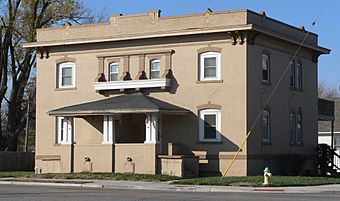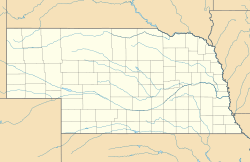Broomfield Rowhouse facts for kids
Quick facts for kids |
|
|
Broomfield Rowhouse
|
|
 |
|
| Location | 2502-2504 Lake Street, Omaha, Nebraska |
|---|---|
| Area | 54 |
| Built | 1913 |
| Architect | Clarence Wesley (Cap) Wigington |
| NRHP reference No. | 07000179 |
| Added to NRHP | March 21, 2007 |
The Broomfield Rowhouse is a special historic building. It is located at 2502-2504 Lake Street in the Near North Side neighborhood of Omaha, Nebraska. This unique home was designed by a very talented African American architect named Clarence W. Wigington. He later became known as a master in his field. His design for this house even won a competition in Good Housekeeping magazine in 1909. Today, the house is listed on the National Register of Historic Places. This means it is recognized as an important part of history.
Contents
A Historic Home in Omaha
This historic rowhouse was built in 1913. It was constructed after a big storm called the Easter Sunday Tornado of 1913. This tornado caused a lot of damage in Midtown and North Omaha. The building was designed by Clarence W. Wigington. He was a well-known African American architect who grew up in Omaha.
The Architect's Winning Design
Clarence W. Wigington first designed this building in 1909. He entered his design into a contest. This contest was organized by Good Housekeeping magazine. Wigington won first prize for the best two-family dwelling. You can see the influence of his teacher, Thomas R. Kimball, in the building's design. Wigington was always looking for a special part of a building to make it stand out.
An Important Owner
The first owner of the Broomfield Rowhouse was Jack Broomfield. He was a very important African American community leader in Omaha. He played a key role in the city's politics during his time.
Why It's a Historic Place
The Broomfield Rowhouse was chosen for the National Register of Historic Places for several reasons. According to Landmarks, Inc., an Omaha preservation group, the house is special because:
- It shows a unique style of building from its time.
- It was designed by a master architect, Clarence W. Wigington.
- It has high artistic value.
- It is a significant building that stands out.



